The Water Cycle (Water Science for Schools)
The Water Cycle ¦ Water Science for Schools ¦ Contact us ¦ Back
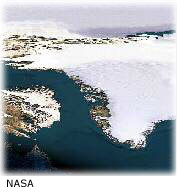 The water cycle describes how water moves above, on, and through the Earth. But, in fact, much more water is "in storage" at any one time than is actually moving through the cycle. By storage, we mean water that is locked up in its present state for a relatively long period of time. Short-term storage might be days or weeks for water in a lake, but it could be thousands of years for deep ground-water storage or even longer for water at the bottom of an ice cap, such as in Greenland. In the grand scheme of things, this water is still part of the water cycle.
The water cycle describes how water moves above, on, and through the Earth. But, in fact, much more water is "in storage" at any one time than is actually moving through the cycle. By storage, we mean water that is locked up in its present state for a relatively long period of time. Short-term storage might be days or weeks for water in a lake, but it could be thousands of years for deep ground-water storage or even longer for water at the bottom of an ice cap, such as in Greenland. In the grand scheme of things, this water is still part of the water cycle.
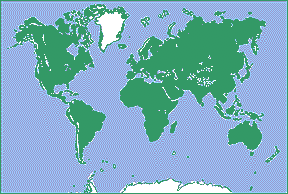 The white areas in this map show glaciers and ice sheets around the world (reproduced from National Geographic WORLD, February 1977, no. 18, p. 6, with permission). The vast majority, almost 90 percent, of Earth's ice mass is in Antarctica, while the Greenland ice cap contains 10 percent of the total global ice mass. The Greenland ice cap is an interesting part of the water cycle. The ice cap became so large over time (about 600,000 cubic miles (mi3) or 2.5 million cubic kilometers (km3)) because more snow fell than melted. Over the millennia, as the snow got deeper, it compressed and became ice. The ice cap averages about 5,000 feet (1,500 meters) in thickness, but can be as thick as 14,000 feet (4,300 meters). The ice is so heavy that the land below it has been pressed down into the shape of a bowl. In many places, glaciers on Greenland reach to the sea, and one estimate is that as much as 125 mi3 (517 km3) of ice "calves" into the ocean each year—one of Greenland's contributions to the global water cycle. Ocean-bound icebergs travel with the currents, melting along the way. Some icebergs have been seen, in much smaller form, as far south as the island of Bermuda.
The white areas in this map show glaciers and ice sheets around the world (reproduced from National Geographic WORLD, February 1977, no. 18, p. 6, with permission). The vast majority, almost 90 percent, of Earth's ice mass is in Antarctica, while the Greenland ice cap contains 10 percent of the total global ice mass. The Greenland ice cap is an interesting part of the water cycle. The ice cap became so large over time (about 600,000 cubic miles (mi3) or 2.5 million cubic kilometers (km3)) because more snow fell than melted. Over the millennia, as the snow got deeper, it compressed and became ice. The ice cap averages about 5,000 feet (1,500 meters) in thickness, but can be as thick as 14,000 feet (4,300 meters). The ice is so heavy that the land below it has been pressed down into the shape of a bowl. In many places, glaciers on Greenland reach to the sea, and one estimate is that as much as 125 mi3 (517 km3) of ice "calves" into the ocean each year—one of Greenland's contributions to the global water cycle. Ocean-bound icebergs travel with the currents, melting along the way. Some icebergs have been seen, in much smaller form, as far south as the island of Bermuda.
The climate, on a global scale, is always changing, although usually not at a rate fast enough for people to notice. There have been many warm periods, such as when the dinosaurs lived (about 100 million years ago) and many cold periods, such as the last ice age of about 18,000 years ago. During the last ice age much of the northern hemisphere was covered in ice and glaciers, and, as this map from the University of Arizona shows, they covered nearly all of Canada, much of northern Asia and Europe, and extended well into the United States.
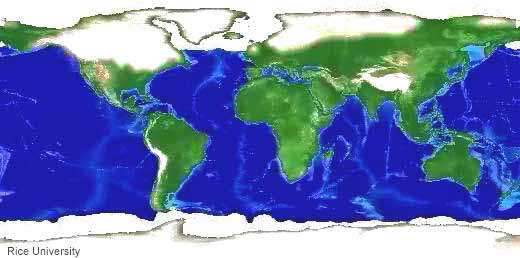
Glaciers are still around today; tens of thousands of them are in Alaska. Climatic factors still affect them today and during the current warmer climate, they can retreat in size at a rate easily measured on a yearly scale.
Just because water in an ice cap or glacier is not moving does not mean that it does not have a direct effect on other aspects of the water cycle and the weather. Ice is very white, and since white reflects sunlight (and thus, heat), large ice fields can determine weather patterns. Air temperatures can be higher a mile above ice caps than at the surface, and wind patterns, which affect weather systems, can be dramatic around ice-covered landscapes.
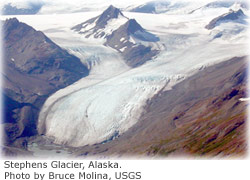
 Even though the amount of water locked up in glaciers and ice caps is a small percentage of all water on (and in) the Earth, it represents a large percentage of the world's total freshwater. As these charts and the data table show, the amount of water locked up in ice and snow is only about 1.7 percent of all water on Earth, but the majority of total freshwater on Earth, about 68.7 percent, is held in ice caps and glaciers.
Even though the amount of water locked up in glaciers and ice caps is a small percentage of all water on (and in) the Earth, it represents a large percentage of the world's total freshwater. As these charts and the data table show, the amount of water locked up in ice and snow is only about 1.7 percent of all water on Earth, but the majority of total freshwater on Earth, about 68.7 percent, is held in ice caps and glaciers.
| Water source | Water volume, in cubic miles | Water volume, in cubic kilometers | Percent of total water | Percent of total freshwater | |
|---|---|---|---|---|---|
| Ice caps, Glaciers, & Permanent snow | 5,773,000 | 24,064,000 | 1.7% | 68.7% | |
| Total global freshwater | 8,404,000 | 35,030,000 | 2.5% | -- | |
| Total global water | 332,500,000 | 1,386,000,000 | -- | -- | |
| Source: Gleick, P. H., 1996: Water resources. In Encyclopedia of Climate and Weather, ed. by S. H. Schneider, Oxford University Press, New York, vol. 2, pp.817-823. | |||||
![]() Glacier Studies - USGS Eastern Earth Surfaces Processes Team
Glacier Studies - USGS Eastern Earth Surfaces Processes Team
![]() Glaicer and Snow Program - USGS Water Resources of Alaska
Glaicer and Snow Program - USGS Water Resources of Alaska
![]() The Ice Cap and the first Icebergs
The Ice Cap and the first Icebergs
![]() Glacier Facts & Figures, National Park Service
Glacier Facts & Figures, National Park Service
![]() Greatest Places Physical Geography:
Greatest Places Physical Geography:
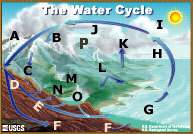 |
A - Storage in ice and snow B - Precipitation C - Snowmelt runoff to streams D - Infiltration E - Ground-water discharge F - Ground-water storage G - Water storage in oceans H - Evaporation |
I - Condensation J - Water storage in the atmosphere K - Evapotranspiration L - Surface runoff M - Streamflow N - Springs O - Freshwater storage P - Sublimation |